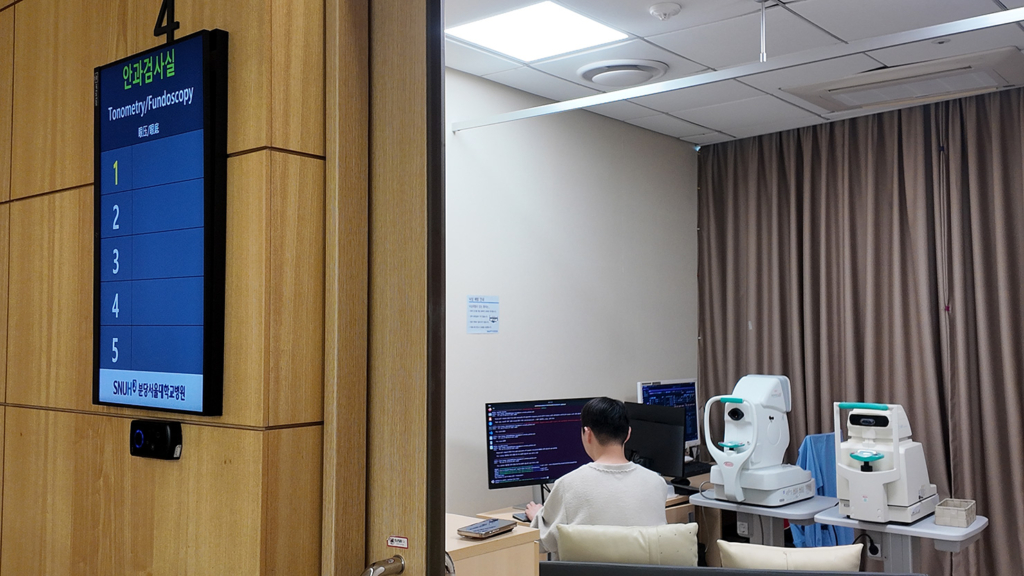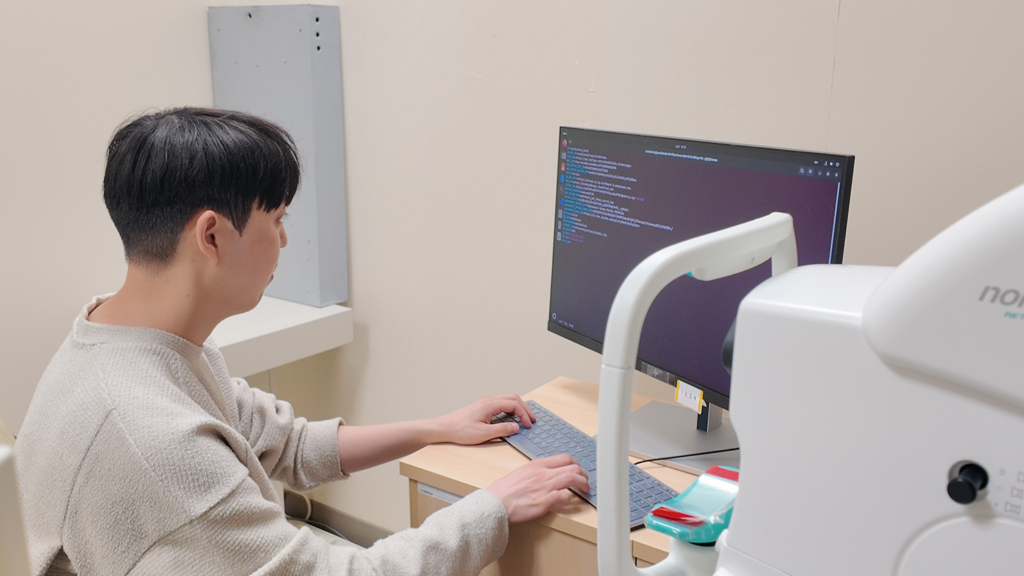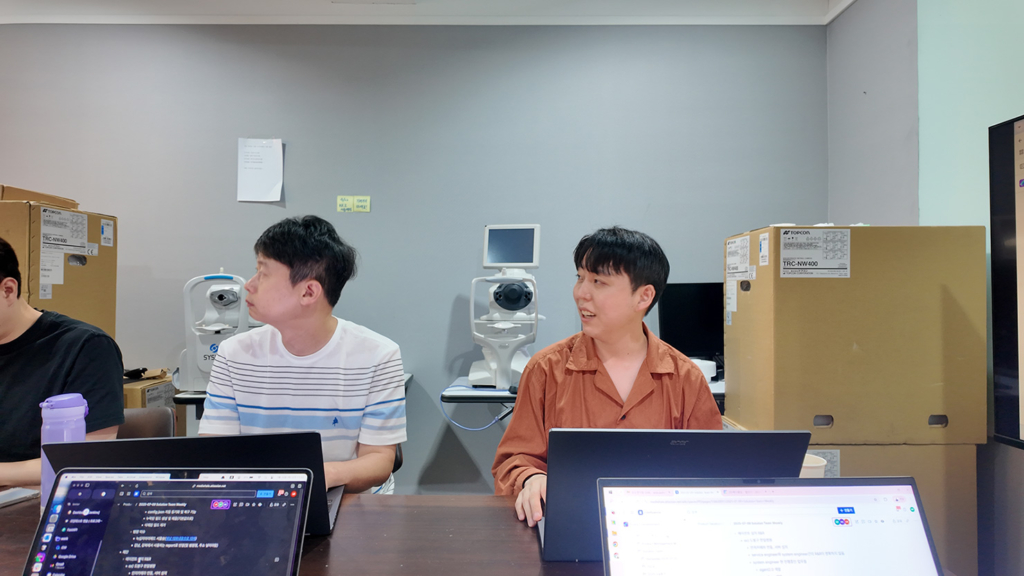The Mediwhale Solution Team bridges the gap between innovative technology and real-world hospital use, ensuring seamless integration, efficient operation, and lasting value for medical staff and patients.
With a “find a way” mindset, they adapt to diverse hospital environments and drive stable adoption of new systems.
In this interview, team leader Jay shares how these solutions come to life in the field and the values guiding their work.
Please introduce the work of the Solution Team.
The Solution Team is responsible for on-site technical support. Our work includes on-premise server installation and maintenance at hospitals and medical institutions, as well as development of the Agent Program. We also handle various technical support tasks tailored to customer needs.
In addition, we develop interface servers that connect hospital systems with Mediwhale’s backend servers. This ensures smooth data integration between on-site operations and Mediwhale’s systems, as well as stable and reliable service.
What is the most important aspect of the Solution Team’s work?
Our main goal is to integrate our developed products (software medical devices) into the actual hospital environment so that healthcare professionals can use them immediately in their daily practice. In doing so, we strive to integrate with existing hospital processes as seamlessly as possible, minimizing disruption.
Making service integration simple and convenient for hospitals means they can operate their medical systems more efficiently. For example, hospitals can easily upload fundus images using our Agent Program and view the resulting reports either directly on their computers or via their PACS or EMR systems.
What kinds of problems do you solve in the Solution Team? Could you share an interesting challenge you’ve faced?
Integration must be tailored to each hospital environment to ensure our services fit smoothly. Since each hospital or clinic uses different software and every EMR/PACS vendor is different, customization is often necessary.
For example, in one case, hospitals previously had to manually enter patient details such as gender and age. We improved the program to receive and process MWL data automatically, making it much easier for hospitals to use our solution.


In some hospitals, internet access is unavailable and all systems run on an internal network. In these cases, we must visit the site directly to install the program, update it in the server room, and verify that it works. If an issue occurs after installation or update, it can be critical in a hospital setting, so we approach such situations more cautiously than in typical development environments.
What do you learn or find fulfilling in your work?
Hospitals already have established workflows, and it’s important for our service to fit naturally into these processes without causing inconvenience. Achieving this requires effective communication with hospital IT teams and end-users.
In the Solution Team, we not only develop and integrate systems but also engage directly with users in the field. By observing how they use our products and incorporating their feedback into improvements, we gain a strong sense of accomplishment.
What technical skills and domain knowledge can someone expect to gain in the Solution Team?
We currently develop the Drnoon Agent Program using Python and Qt. The program uploads images from hospital fundus cameras to our servers and retrieves the results. When installing servers on hospital internal networks, we use Ubuntu servers with Docker to configure services, implement Nginx, and create stabilization scripts to ensure system reliability.
You’ll gain hands-on experience in receiving fundus images, delivering reports to hospital systems, deploying and maintaining services in Linux environments, and integrating with EMR/PACS systems. This role offers skills in Python, Qt, Linux deployment and maintenance, and healthcare IT integration.
Your work involves technical issue response, Agent Program development, and regulatory documentation. How does this role foster learning and growth?
Our responsibilities extend beyond development to field installations and the creation of regulatory documents required for medical devices. In the process, we often collaborate with sales teams and hospital representatives.
Since everyone involved has different priorities, it’s important to understand their needs and find technical solutions that meet them. Through this, you not only improve your technical expertise but also develop strong communication skills.
Which teams do you collaborate with most, and how?
We work closely with the Sales Team and the SaMD Team. When the Sales Team receives a request, the Solution Team collects and reviews it. If the request requires service development, we forward it to the SaMD Team and support the process until the service update is completed.
Does the team have a culture of sharing skills or promoting learning?
During team meetings, we share any new integration methods or approaches we’ve tried at hospitals. Recently, one team member set up a CLI to run Q/A for the Agent Program via Gemini and tested it, later sharing the results with the entire development team.
When a new team member joins, we hold an onboarding session to introduce our ongoing projects. We also maintain integration documentation so new members can adapt more quickly. In weekly meetings, we review our goals and prioritize tasks together.

What kind of people make up the Solution Team?
Our service engineers are often in the field, so they tend to be outgoing and strong communicators. Our system engineers are persistent problem-solvers who work on integration and overcome challenges in new hospital environments.
What can you learn from your colleagues?
Some team members have extensive experience with hospital systems and have personally deployed and maintained Linux servers, which offers valuable technical insights. Service engineers demonstrate strong communication skills through their interactions with healthcare professionals in the field.
What projects or initiatives is the team currently focusing on?
We are working to integrate our systems not only with domestic hospital systems but also with international ones. Since overseas hospitals use different systems from those in Korea, we are studying their environments and developing integration methods accordingly.
We are also refining our internal processes to reduce repeat site visits for the same issues, improving efficiency.
How do you envision the Solution Team’s growth, and what do you expect from new team members?
Our goal is to integrate, maintain, and manage hospital systems as efficiently and simply as possible. As new systems inevitably emerge, we hope new members will adopt a “find a way to make it work” mindset rather than saying “it can’t be done.”